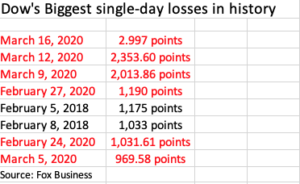$cott Kahan: Like I was saying…

$cott Kahan: Like I was saying… It’s been a wild ride since we last checked in with our “resident” financial adviser Scott Kahan on February 27. At that time, Scott, a Certified Financial Planner professional and CEO of Financial Asset Management Corp. of NYC and Chappaqua, offered a “keep calm and carry on“. We spoke with him today to see how well that message was received by his 175 clients with $250 million dollars in assets.
So, how good were your clients at keeping calm?
 Let’s just say that these are good times to test people’s risk tolerance levels.
Let’s just say that these are good times to test people’s risk tolerance levels.
Constructively speaking…
It’s been a very volatile time in the markets. And people’s emotions have been all over the place. While we cautioned our clients for a 10-15% correction since Q4 2019, no one could have anticipated a pandemic as the cause. Nor could anyone have foreseen the speed of the 38% drop we saw in the market. Between February 24 and March 16 we had five days of 1,000+ point declines on the Dow. Including three 2,000+ point drops over six trading days from March 9-16.
Then we had a quick 40% comeback and people get calmer. That’s why you can’t try to time the market. No one forecast either of those moves. Any time you see a 40% increase in equities you have to have a correction. I would not be surprised to see a 10 to 15% correction. Markets can be irrational in the short term. And markets tend to recover when things look the worst. But if you don’t want to buy when markets look the worst you have to reassess your risk tolerance levels.
In practice, how does that work?
There’s no set rules on this. For simplicity, let’s take a standard 60% equity/40% fixed income portfolio. Investors got a chance, in a very short space of time, to see if they can really handle the amount of risk they thought they could. And some were okay. Others not so much. I had one couple who were toying with upping their allocations to 70% equities because  they heard someone on TV say this is becoming accepted even for retirees because interest rates are so low. After watching the losses in their 401K accounts, they said they could handle it but not a penny more. That was a constructive exercise for them. They’re more comfortable with their financial plan now. And glad they didn’t try to stretch.
they heard someone on TV say this is becoming accepted even for retirees because interest rates are so low. After watching the losses in their 401K accounts, they said they could handle it but not a penny more. That was a constructive exercise for them. They’re more comfortable with their financial plan now. And glad they didn’t try to stretch.
Others said they would like to take less risk now. So we asked, “when would you feel more comfortable taking risk?” “When the market goes up.” Well, we all know that’s not a winning strategy. So we looked at the impact of permanently decreasing risk in their portfolio. And how it would affect reaching their overall goals. Often the impact of adjusting your allocations 5 or 10% is not that great. And for many people it is worth it if it helps them sleep at night. However, if you want to drop to 30% equities – now you have to talk a hard look at your goals.
Out goes the waterfront home. In comes the water view home.
Yeah, the short-cut plan to retirement planning is saying I need 70% of my current income for retirement. There’s nothing wrong with planning for a dream retirement because otherwise what’s the point? You have to have a dream. If your risk assumptions were way off, you need to build a baseline plan against needed expenses – not income. Let’s say you need $10,000 a month. If you can get to your adjusted goal with less risk you’re in good shape. If not, and you want to reduce risk, you need to save more. If you can save more, you’re in good shape. If you can’t, you have to accept more risk or pare back on your dream scenario. Maybe not all the way to a baseline plan. Maybe somewhere in between. That’s the constructive lessons of experiencing market volatility.
Let’s talk about your clients who saw the buying opportunity in the markets

Some clients were more comfortable than others. But going all-in was difficult even for them. For people investing monthly in 401K’s, we recommended they continue to do so. Most were comfortable with that. But new money is tougher. People are more likely to say. ‘let’s wait’. So we talk about dollar cost averaging. Investing a portion of your cash in the market each month over a year, or more if it’s a large sum of money. Basically we’re using the 401K model that people know to commit new money. But not all at once. Because we don’t know where the bottom is.
We also had clients who usually are very disciplined about re-balancing their portfolios who chose not to backfill their equities. Instead, they chose to let their allocations organically rebalance over time. It’s important to stress that although we preach rebalancing, you don’t have to buy every move. In a volatile market that becomes like trading. So we advocate building some variance into your allocations. Ignoring a five to ten percent variance within your portfolio due to uncertainty is fine. We don’t try to time the market.
Just like that the market is down 1,800 points as we speak?
 Not surprising. I said we’re due for another correction. We’re not through this. The good news is that the Federal Reserve and Congress acted very quickly this time compared to 2008-9. And all forecasts suggest we are looking at low interest rates for 3 to 5 years. So we will get through this as we have every time in the past. This is just going to be different. But, every time it’s different. If you are looking at money you don’t need for the next several years – history shows markets come back. We had a pandemic in 1918 and this was before we had the science and technology we have today. The market has returned some very nice gains since then.
Not surprising. I said we’re due for another correction. We’re not through this. The good news is that the Federal Reserve and Congress acted very quickly this time compared to 2008-9. And all forecasts suggest we are looking at low interest rates for 3 to 5 years. So we will get through this as we have every time in the past. This is just going to be different. But, every time it’s different. If you are looking at money you don’t need for the next several years – history shows markets come back. We had a pandemic in 1918 and this was before we had the science and technology we have today. The market has returned some very nice gains since then.
That said, it may not come back exactly like it was before. Some sectors, like airlines, retail and commercial real estate, are going to take longer to come back than other sectors. So, it won’t be a uniform bounce back. Finally, this all could be good news for Westchester real estate. The three-month lockdown in New York City and the ramifications of a dense population during a pandemic has clearly taken the luster off living in Manhattan. With low interest rates, and the prospect of more people working at home, the demand for larger homes, and the tolerance for homes farther from town should drive local home prices up. And then if we get a Democratic administration in the fall you can expect the SALT tax to get repealed. So chin up – on a clearly dismal day.
Financial Asset Management Corporation has provided fee-only financial planning and wealth management services for individuals and small businesses in the Tri-State area since 1986. They serve 175 clients and manage over 250 million dollars in assets. (26 South Greeley Avenue, Chappaqua, NY, (914) 238-8900; www.famcorporation.com )
More on What To Do from Scott Kahan here:

















